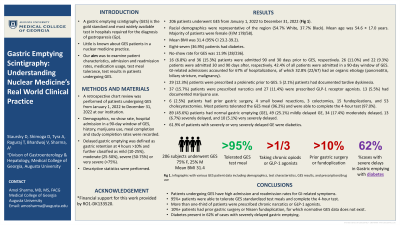Tuesday Poster Session
Category: Functional Bowel Disease
P4050 - Gastric Emptying Scintigraphy: Understanding Nuclear Medicine’s Real World Clinical Practice
Tuesday, October 29, 2024
10:30 AM - 4:00 PM ET
Location: Exhibit Hall E

Has Audio
- DS
Daniel Staursky, MD
Augusta University
Augusta, GA
Presenting Author(s)
Daniel Staursky, MD1, Dhanush Shimoga, MBBS2, Amanda Tyra, MS2, Tharshika Raguraj, MD1, Vikarsh Bhardwaj, MBBS3, Amol Sharma, MS, MD, FACG2
1Augusta University, Augusta, GA; 2Medical College of Georgia at Augusta University, Augusta, GA; 3Jawaharlal Nehru Medical College, New Dehli, Delhi, India
Introduction: A gastric emptying scintigraphy (GES) is required for the diagnosis of gastroparesis (Gp). Little is known about GES patients in a nuclear medicine practice. Our aim was to examine patients undergoing GES.
Methods: A retrospective chart review was performed of patients undergoing GES from January 1, 2022 to December 31, 2022 at our institution. Demographics, no show rate, hospital admission in a 90-day window of GES, history, marijuana use, meal completion and study completion rates were recorded. Delayed gastric emptying was defined as gastric retention at 4 hours >10% and further classified as mild (10-25%), moderate (25-50%), severe (50-75%) or very severe ( >75%). Descriptive statistics were performed.
Results: 206 patients underwent GES. Racial demographics were representative of the region (54.7% White, 37.7% Black). Mean age was 54.6 ± 17.0 years. Majority of patients were female (F/M 178/58). Mean BMI was 31.4 (95% CI 23.2-39.2). Eight-seven (36.9%) patients had diabetes. No-show rate for GES was 11.9% (28/236). 16 (6.8%) and 36 (15.3%) patients were admitted 90 and 30 days prior to GES, respectively. 26 (11.0%) and 22 (9.3%) patients were admitted 30 and 90 days after, respectively. 42.4% of all patients were admitted in a 90-day window of GES. GI-related admissions accounted for 67% of hospitalizations, of which 32.8% (22/67) had an organic etiology (pancreatitis, biliary stricture, malignancy). 29 (12.3%) patients were prescribed a prokinetic prior to GES. 5 (2.1%) patients had documented tardive dyskinesia. 37 (15.7%) patients were prescribed narcotics and 27 (11.4%) were prescribed GLP-1 receptor agonists. 13 (5.5%) had documented marijuana use. 6 (2.5%) patients had prior gastric surgery, 4 small bowel resection, 3 colectomy, 15 fundoplications, and 53 cholecystectomies. Most patients tolerated the GES meal (96.2%) and were able to complete the 4-hour test (97.0%). 89 (45.6%) patients had normal gastric emptying (GE), 49 (25.1%) mildly delayed GE, 34 (17.4%) moderately delayed, 13 (6.7%) severely delayed, and 10 (5.1%) very severely delayed. 61.9% of patients with severely or very severely delayed GE were diabetics.
Discussion: This study demonstrates patients undergoing GES have high admission rates. Nearly all GES tests complete 4 hours and meals are tolerated. Further efforts and investigation are needed to ensure appropriate patient selection and access for GES.
This work is supported by RO1-DK133520.
Disclosures:
Daniel Staursky, MD1, Dhanush Shimoga, MBBS2, Amanda Tyra, MS2, Tharshika Raguraj, MD1, Vikarsh Bhardwaj, MBBS3, Amol Sharma, MS, MD, FACG2. P4050 - Gastric Emptying Scintigraphy: Understanding Nuclear Medicine’s Real World Clinical Practice, ACG 2024 Annual Scientific Meeting Abstracts. Philadelphia, PA: American College of Gastroenterology.
1Augusta University, Augusta, GA; 2Medical College of Georgia at Augusta University, Augusta, GA; 3Jawaharlal Nehru Medical College, New Dehli, Delhi, India
Introduction: A gastric emptying scintigraphy (GES) is required for the diagnosis of gastroparesis (Gp). Little is known about GES patients in a nuclear medicine practice. Our aim was to examine patients undergoing GES.
Methods: A retrospective chart review was performed of patients undergoing GES from January 1, 2022 to December 31, 2022 at our institution. Demographics, no show rate, hospital admission in a 90-day window of GES, history, marijuana use, meal completion and study completion rates were recorded. Delayed gastric emptying was defined as gastric retention at 4 hours >10% and further classified as mild (10-25%), moderate (25-50%), severe (50-75%) or very severe ( >75%). Descriptive statistics were performed.
Results: 206 patients underwent GES. Racial demographics were representative of the region (54.7% White, 37.7% Black). Mean age was 54.6 ± 17.0 years. Majority of patients were female (F/M 178/58). Mean BMI was 31.4 (95% CI 23.2-39.2). Eight-seven (36.9%) patients had diabetes. No-show rate for GES was 11.9% (28/236). 16 (6.8%) and 36 (15.3%) patients were admitted 90 and 30 days prior to GES, respectively. 26 (11.0%) and 22 (9.3%) patients were admitted 30 and 90 days after, respectively. 42.4% of all patients were admitted in a 90-day window of GES. GI-related admissions accounted for 67% of hospitalizations, of which 32.8% (22/67) had an organic etiology (pancreatitis, biliary stricture, malignancy). 29 (12.3%) patients were prescribed a prokinetic prior to GES. 5 (2.1%) patients had documented tardive dyskinesia. 37 (15.7%) patients were prescribed narcotics and 27 (11.4%) were prescribed GLP-1 receptor agonists. 13 (5.5%) had documented marijuana use. 6 (2.5%) patients had prior gastric surgery, 4 small bowel resection, 3 colectomy, 15 fundoplications, and 53 cholecystectomies. Most patients tolerated the GES meal (96.2%) and were able to complete the 4-hour test (97.0%). 89 (45.6%) patients had normal gastric emptying (GE), 49 (25.1%) mildly delayed GE, 34 (17.4%) moderately delayed, 13 (6.7%) severely delayed, and 10 (5.1%) very severely delayed. 61.9% of patients with severely or very severely delayed GE were diabetics.
Discussion: This study demonstrates patients undergoing GES have high admission rates. Nearly all GES tests complete 4 hours and meals are tolerated. Further efforts and investigation are needed to ensure appropriate patient selection and access for GES.
This work is supported by RO1-DK133520.
Disclosures:
Daniel Staursky indicated no relevant financial relationships.
Dhanush Shimoga indicated no relevant financial relationships.
Amanda Tyra indicated no relevant financial relationships.
Tharshika Raguraj indicated no relevant financial relationships.
Vikarsh Bhardwaj indicated no relevant financial relationships.
Amol Sharma indicated no relevant financial relationships.
Daniel Staursky, MD1, Dhanush Shimoga, MBBS2, Amanda Tyra, MS2, Tharshika Raguraj, MD1, Vikarsh Bhardwaj, MBBS3, Amol Sharma, MS, MD, FACG2. P4050 - Gastric Emptying Scintigraphy: Understanding Nuclear Medicine’s Real World Clinical Practice, ACG 2024 Annual Scientific Meeting Abstracts. Philadelphia, PA: American College of Gastroenterology.
